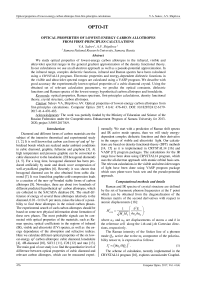Optical properties of lowest-energy carbon allotropes from first-principles calculations
Автор: Saleev Vladimir Anatolievich, Shipilova Alexandra Victorovna
Журнал: Компьютерная оптика @computer-optics
Рубрика: Opto-it
Статья в выпуске: 4 т.41, 2017 года.
Бесплатный доступ
We study optical properties of lowest-energy carbon allotropes in the infrared, visible and ultraviolet spectral ranges in the general gradient approximation of the density functional theory. In our calculations we use an all-electron approach as well as a pseudo-potential approximation. In the infrared range, complex dielectric functions, infrared and Raman spectra have been calculated using a CRYSTAL14 program. Electronic properties and energy-dependent dielectric functions in the visible and ultraviolet spectral ranges are calculated using a VASP program. We describe with good accuracy the experimentally known optical properties of a cubic diamond crystal. Using the obtained set of relevant calculation parameters, we predict the optical constants, dielectric functions and Raman spectra of the lowest-energy hypothetical carbon allotropes and lonsdaleite.
Optical properties, raman spectrum, first-principles calculations, density functional theory, crystal structure, carbon allotropes
Короткий адрес: https://sciup.org/140228630
IDR: 140228630 | DOI: 10.18287/2412-6179-2017-41-4-476-483.
Текст научной статьи Optical properties of lowest-energy carbon allotropes from first-principles calculations
Diamond and different forms of carbon materials are the subject of the intensive theoretical and experimental study [1, 2]. It is well known that carbon can form sp2 and sp3 hybridized bonds which are realized under ambient conditions in cubic diamond, graphite, fullerene and graphene [3]. At high temperature and pressure graphite can be converted to cubic diamond or to the lonsdaleite (2H hexagonal diamond) [4, 5]. For a long time, hexagonal diamond has been produced artificially by static and shock wave compression of well-crystallized graphites [6]. Recently it was shown that hexagonal diamond can be also obtained from cubic diamond [7]. It was found that graphite cold-compression leads to a creation of the new sp3-bonded stable forms of carbon allotropes [8]. Nowadays, there are about two hundreds of different predicted hypothetical sp3 carbon allotropes, which are collected in the SACADA database [9]. The small difference of energy of several these allotropes relatively to the diamond, 0.01–0.10 eV per atom, raises the idea of a possibility to find these allotropes in the mixed carbon phases. The experimental search of such carbon allotropes should be based on some new physical information about formation of these new phases. The most probable signals can be connected with optical properties of the materials, such as Raman spectra, optical coefficients in the regions of infrared (IR), visible and ultraviolet (UV) spectra, as well as the energy dependence of the absorption and refractive indices. Here we calculate different optical properties of the six low-est-energy sp3 carbon allotropes: cubic diamond, lonsdaleite [4], 4H-diamond [10], SiC12 [11], C28 [12] and mtn [13]. The main goal of our study is to find the quantitative level of difference between optical properties of cubic diamond and relevant carbon allotropes, which can be measured experi- mentally. We start with a prediction of Raman shift spectra and IR active mode spectra, than we will study energydependent complex dielectric functions and their derivative in the ranges of visible and ultraviolet light. Our calculations are based on density-functional-theory (DFT) methods [14, 15] as it is implemented in CRYSTAL14 [16] and VASP [17] program packages. The calculations for the IR range have been done using CRYSTAL14 program, which uses the all-electron approach with atomic orbital basis sets. The relevant calculations in the visible and ultraviolet ranges of light have been done using VASP program package which uses plane-wave basis sets and the pseudo-potential approach.
Computational methods and details
Raman and IR spectra of crystal structure are defined by the set of harmonic phonon frequencies at the Γ point which can be obtained from the diagonalization of the Hessian matrix of the second derivatives with respect to atomic displacements [18]:
H r. = 1
ai , bj M a M b
f d 2 E ) b ( d u ai d u j J
where u ai and u bj are displacements of atoms a and b in the reference cell along the i-th and j-th Cartesian directions, respectively.
The Raman intensity of the Stokes line of a phonon mode Q p , active due to the a у component of the polarizability tensor a , is expressed as follows:
i>4da у / d Q p ) 2 . (1)
The scheme of calculation, recently implemented in the CRYSTAL14 program [16], explores second-order Coupled-
Perturbed Hartree-Fock/Kohn-Sham (CPHF/KS) equations [19]. The Raman spectrum is then computed by considering the transverse optical (TO) modes and by adopting a pseudoVoigt functional form: a linear combination of a Lorentzian and a Gaussian curve with full width at half maximum of 8 cm-1. Raman intensities are normalized so that the largest value is conventionally set to 100 a.u.
To calculate IR spectra we should know the complex dielectric tensor ε ii ( v ) which is computed for each inequivalent polarization direction on the basis of a classical Drude-Lorentz model:
ε ii ( ν ) =ε opt , ii + ∑ f p , ii ν 2 p /( ν 2 p -ν 2 - i νγ p ), (2) p
where ii indicates the polarization direction, ε opt,ii is the optical dielectric tensor, v p , f p and γ p are the TO frequency, oscillator strength and damping factor for the p-th vibration mode, respectively. The real and imaginary parts of ε ii ( v ) are computed and the maxima of this function correspond to the TO frequencies. The optical or high-frequency dielectric tensor is computed in a quasi-free electron approximation via coupled perturbed Hartree-Fock (Kone-Sham) method [20]. The refractive (n) and absorption (k) indices are computed as real and imaginary parts of the complex refractive index n * ( ν ) = ε , also for
each inequivalent polarization direction.
In the projector augmented plane wave method realized in VASP the frequency-dependent dielectric functions is obtained in the random phase approximation, where the imaginary part of the frequency-dependent dielectric tensor is written as
ε (2) ( ω ) = (4 π 2 e 2 / Ω )lim(1/ q 2 ) ∑ 2 w ×
αβ q → 0 c , v , k k
×δ ( ε ck -ε vk -ω ) u ck + e q | u vk V u ck + e q | u vk ck vk ck + e α q vk ck + e β q vk ,
where the indices c and v refer to conduction and valence
band states respectively in the sum over the empty states, ε c,vk are the corresponding eigenenergies, Ω is the volume of a primitive cell, k-point weights w k are defined such that they sum to 1, e α , β are the unit vectors for the three Cartesian directions, and u ck is the cell-periodic part of the orbitals at point k. The real part of the dielectric tensor ε ( α 1 β ) ( ω ) is ob-
tained by the Kramers-Kronig transformation
ε(α1β) (ω) =1+π2P∫0∞
ε(αβ)(ω′)ω′
ω′ 2
-
2 . ■ ω +iη
d ω ,
where P denotes the principal value. By cubic symmetry, the following relation is satisfied for diamond and mtn
ε ( x 1 x ,2) =ε ( y 1 y ,2) =ε ( z 1 z ,2) , ε ( α 1 β ,2) = 0, α≠β , (5)
so the real and imaginary parts of the complex dielectric constant ε = ε1+iε2 can be determined by ε = ε(1,2) . In 1,2 xx the case of the other, anisotropic, structures we use the average values:
ε 1,2 =ε 1,2 = (1/3)( ε ( x 1 x ,2) +ε ( y 1 y ,2) +ε ( z 1 z ,2) ).
Computational setup, CRYSTAL14
We use the two schemes of DFT calculations, both are implemented in the CRYSTAL14 program [16]. The
first one incorporates the Perdew-Burke-Ernzerhof (PBE) exchange-correlation functional [21] at general gradient approximation (GGA) of DFT and POB-TZVP allelectron basis set [22], and the second one – the B3LYP hybrid functional [23] and adopted Pople’s 6-21G Gaussian all-electron basis set [24, 25]. The level of accuracy of calculating the energies of Coulomb and Hartree-Fock exchanges is controlled by a set of TOLINTEG parameters, which were chosen as {8, 8, 8, 8, 18}. The convergence threshold on energy for the self-consistent-field (SCF) calculations is 10–7 Hartree for structural optimization and 10–8 Hartree for vibration frequency calculations. The number of basis vectors in the irreducible Brillouin zone is given by the shrink parameter IS = 8 for structural optimization and IS = 16 for vibration frequency calculations. The relaxation of cell parameters and atomic positions to equilibrium values was carried out until the lattice stress became less than 0.02 GPa.
Computational setup, VASP
The computations of the complex dielectric functions in the visible and ultraviolet regions were performed by the VASP package [17] at the level of GGA and with two functionals: the above-mentioned PBE [21] and the screened Heyd, Scuseria, and Ernzerhof (HSE06) hybrid functional [26], since the latter is well-suited to reproduce the electronic properties including the band gaps of a number of elemental and binary insulators and semiconductors. For this purpose, at first we performed the relaxation of the discussed structures with a cutoff energy of 700 eV for the plane-wave basis set, until the energy was converged up 10–7 eV per unit cell and the residual stress was less than 10–5 eV per atom. The integration over the Brillouin zone was performed using Monkhorst-Pack grids with the number of k-points along each direction of the reciprocal cell equal to an integer divisor of 25Å over the length of corresponding lattice vector. The chosen set of input parameters gives the reliable results for the main physical properties of diamond as it was shown in our previous work [12].
Structural properties
The full geometry optimization of studied structures have been performed using the quasi-Newton algorithm in CRYSTAL14 program. The relaxed lattice constants and atomic Wyckoff positions are presented in the Tables 6 and 7. The differences between lattice constants obtained in two schemes of calculations are about 1 %. While the energy differences per atom relatively diamond are equal, see Tables 1 and 2. To check a mechanical stability of hypothetical allotropes under study, we calculated the elastic constants and phonon spectra which are collected in the Fig. 4. Our results for structural properties agree with previous DFT calculations [10 – 13].
Raman and IR spectra
Raman identification of new carbon allotropes needs a precise calculation of vibration spectra. We performed these calculations applying quasi-harmonic approximation at the Г point as it was done for Raman identification of
lonsdaleite in Refs. [27, 28] and for Raman spectroscopy of nanocrystalline diamond in Ref. [29]. We have found for cubic diamond that the position of single Raman peak, corresponding to the first-order scattering of F 2g symmetry, is 1297 cm–1 (PBE, POB-TZVP ) and 1332 cm–1 (B3LYP, 6-21G). The last one is in a best agreement with experimental value. Such a way, we perform calculations of Raman and IR spectra here and after using B3LYP exchangecorrelation functional and modified Pople’s 6–21 basis set [25]. The presented in Fig. 1 polycrystalline (powder) Raman spectra were computed by averaging over the all possible orientations of the crystallites.
Table 1. Energy difference per atom relatively diamond, density and bulk modulus of the allotrope (PBE, POB-TZVP)
|
Structure |
ΔE/atom, eV |
ρ, g/cm3 |
B, GPa |
|
diamond |
0.00 |
3.51 |
443 |
|
4H-diamond |
0.01 |
3.61 |
445 |
|
SiC12 |
0.01 |
3.53 |
444 |
|
lonsdaleite |
0.03 |
3.51 |
445 |
|
C28 |
0.07 |
3.35 |
427 |
|
mtn |
0.11 |
3.06 |
383 |
Table 2. Energy difference per atom relatively diamond, density and bulk modulus of the allotrope (B3LYP, 6-21G)
|
Structure |
ΔE/atom, eV |
ρ, g/cm3 |
B, GPa |
|
diamond |
0.00 |
3.43 |
428 |
|
4H-diamond |
0.01 |
3.53 |
429 |
|
SiC12 |
0.01 |
3.43 |
428 |
|
lonsdaleite |
0.03 |
3.43 |
429 |
|
C28 |
0.07 |
3.37 |
413 |
|
mtn |
0.08 |
2.98 |
371 |
For the lonsdaleite we predict three Raman active modes: E 1g (1336), A 1g (1312) and E 2g (1209). Up to now, the pure monocrystalline lonsdaleite have not been found or synthesized and there is a well-known problem of correct diagnostics of lonsdaleite phase within cubic diamond-lonsdaleite intergrowths. Possible attendance of nanocrystalline cubic diamond can be a reason of incorrect interpretation of Raman spectra in experimental study. It was found that the Raman modes dynamics under laser heating allows splitting of cubic diamond and lonsdaleite modes and recognize diamond polymorphs [28]. The measurements in the region of 1300 – 1340 cm–1 show the presence of two Raman active modes, A 1g (1319) and F 1g (1322). The control measurement for co-sized cubic diamond particles give downshift of a Raman active mode F 2g (1332) up to 1326 cm–1. Taking into account this downshift effect, we can declare the agreement of our prediction with the experimental data for lonsdaleite [28] at least for two high-frequency modes. We also obtain a rough agreement with recent measurements of Ref. [29], in which the most intensive band at 1292 – 1303 cm–1 and at 1219-1244 cm–1 are interpreted as contributions from A 1g and E 2g vibration modes of lonsdaleite phase in Pop-igai impact rock. Early DFT calculations, performed in the local density approximation (LDA), gave the following results: E 1g (1312), A 1g (1305), E 2g (1193) [30] and E 1g (1338), A 1g (1280), E 2g (1221) [31].
In Fig. 1 a – e , we present our results for polycrystalline (powder) Raman spectra with intensity plotted in arbitrary units. Of course, it has the dependence on direction for monocrystalline structures, but it is small and we discuss it later for real refractive indices only. The single peak of cubic diamond corresponding F 2g (1332) mode is shown in all figures for comparison.
The number of active Raman modes or peaks depends on symmetry of crystal lattice and on the number of nonequivalent atoms in the asymmetric unit. As we see, quantum-mechanical approach predicts a very specific Raman spectrum for every allotrope, which can be considered as “finger prints” of these structures in the experimental search. The improvement of experimental methods to the level of accuracy of theoretical calculations will be crucial for search and recognition of diamond polymorphs.
The high-frequency refractive indices n ii for different direction ( ii = xx , yy , zz ), accordingly Voigt notation, are collected in the Table 3. The calculation with PBE functional and POB-TZVP basis set gives answer which is very close to the experimental value for cubic diamond (~2.40) instead of the calculation with B3LYP functional used successfully for Raman spectrum calculation. The refractive asymmetry factor can be defined as follows A ij = 2( n ii – n jj ) / ( n ii + n jj ). The values of A ij for lonsdaleite, C28, sic12 and 4H-diamond are about 2.5–3.5 %. This is enough large values for experimental test and recognition. The list of calculated IR active modes which initiate absorption of light in IR region are presented in Table 4. The ideal cubic diamond and lonsdaleite crystals do not absorb IR light. It means that experimental viewing of absorption for diamond-like structures may be used for recognition of new sp3 carbon allotropes.
Table 3. High-frequency refractive indices along the different directions
|
Basis set Structure |
POB-TZVP, PBE n xx, n yy, n zz |
Pople-6-21G, B3LYP n xx, n yy, n zz |
|
Diamond |
2.40, 2.40, 2.40 |
2.34, 2.34, 2.34 |
|
lonsdaleite |
2.36, 2.36, 2.44 |
2.30, 2.30, 2.36 |
|
Mtn |
2.11, 2.11, 2.11 |
2.10, 2.10, 2.10 |
|
SiC12 |
2.38, 2.38, 2.42 |
2.32, 2.32, 2.36 |
|
C28 |
2.35, 2.38, 2.43 |
2.29, 2.32, 2.36 |
|
4H-diamond |
2.37, 2.37, 2.43 |
2.32, 2.32, 2.34 |
Table 4. IR active modes
|
Basis set Structure |
Pople-6-21G, B3LYP |
|
SiC12 |
E u (425), E u (578), A 2u (728), A 2u (1075), E u (1271),A 2u (1330) |
|
4H-diamond |
E 1u (1248), A 2u (1316) |
|
C28 |
B 2u (443), B 2u (539), B 3u (547), B 1u (586), B 1u (719), B 3u (742), B 2u (786), B 2u (862), B 3u (878), B 2u (962), B 3u (1000), B 2u (1002), B 1u (1071), B 3u (1074), B 3u (1172), B 3u (1203), B 2u (1211), B 1u (1220), B 2u (1239), B 1u (1260), B 2u (1278), B 3u (1279), B 3u (1298), B 3u (1352), B 2u (1356), B 2u (1400) |
|
mtn |
F 1u (735), F 1u (871), F 1u (891), F 1u (1059), F 1u (1144), F 1u (1223), |
c)
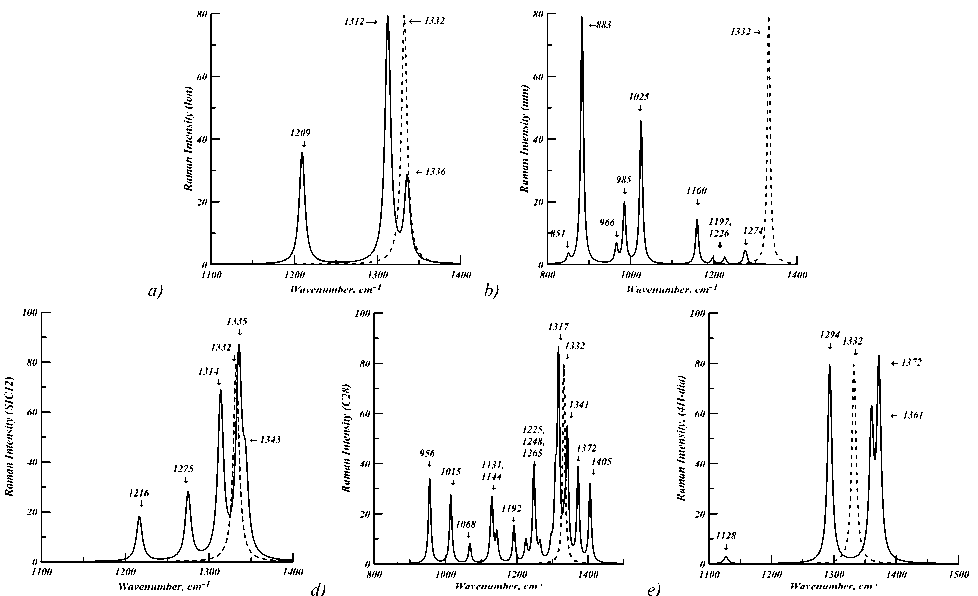
Fig. 1. Raman shift spectra in arbitrary units for carbon allotropes: a) lonsdaleite, b) mtn, c) SiC12, d) C28, e) 4H-diamond. The peak at the 1332 cm–1 in all panels corresponds cubic diamond
Optical and UV spectra
Optical properties are immediately connected with the electronic band structure of the crystal. To calculate the interband and intraband electron optical transitions one needs to solve the band structure of the system and know its band gap in different symmetry points of reciprocal space. Because of this reason, we calculated the electronic band structure for all the allotropes under study (see Fig. 5) and collected to the table our results for indirect and direct (in Г– point) band gaps for all the considered structures within PBE and HSE06 functionals (see Table 5). It is well-known that the former fails to reproduce the optical band gaps while the latter provides the reliable results. Our result of 5.38 eV band gap for diamond successfully reproduces the well-known experimental value of 5.47 eV [1].
Then, we calculated the complex dielectric function for diamond, lonsdaleite and considered lowest-energy allotropes in the random phase approximation as it was explained in the Sec. “Computational methods and Details”. In the Figs. 2 and 3 we present our predictions for diamond obtained with PBE exchange-correlation functional (bold solid line) and HSE06 functional (dashed line) together with experimental data (solid line) from the work [1] and PBE based predictions for lonsdaleite (dash-dotted line). We find a good agreement between theory and experiment within PBE functional calculations in the position and highness of the peaks, while with the HSE06 functional calculations, although providing correct optical band gaps, leads to the shift of the peaks approximately to 1 eV towards the high frequencies. Also, our results for cubic diamond and lonsdaleite are consistent with the earlier calculations in the work [32].
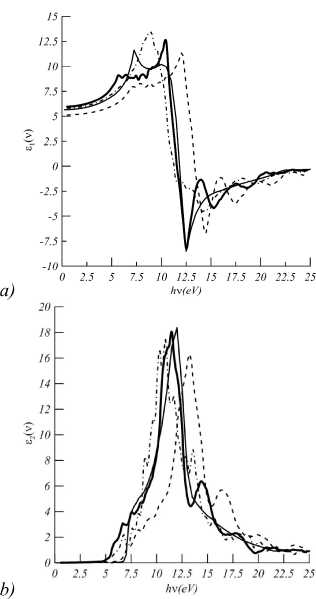
Fig. 2. Real (a) and imaginary (b) dielectric functions: solid line – experiment for cubic diamond, bold solid line – predictions for cubic diamond in PBE, dashed line – predictions for cubic diamond in HSE, dash-dotted line – lonsdaleite in PBE
strate the very similar behavior of ε 1,2 ( v ) to diamond or loncdaleite in the optical and UV region, so they do not lose the desirable optical parameters of diamond. In contrast, the mtn shows 2 times shorter and the smoothest peaks and has the smallest band gap in comparison to other allotropes, but the position of the peaks remains the same. Such a way, a presence of mtn in the polycrystalline sample can contribute a visual opacity.
The effect of the anisotropy of the optical properties for non-cubic structures is found to be small, so we do not show the dependence of the dielectric tensor from the crystal directions in the figures, but only the average values as defined by formula (2.6).
Table 5. Band gaps for carbon allotropes
|
Structure |
PBE, indirect |
HSE06, indirect |
PBE, direct |
HSE06, direct |
|
diamond |
4.67 |
5.38 |
5.64 |
7.04 |
|
lonsdaleite |
3.34 |
4.91 |
4.96 |
6.37 |
|
mtn |
3.76 |
5.09 |
3.76 |
5.03 |
|
Sic21 |
4.44 |
5.64 |
5.25 |
6.65 |
|
C28 |
4.77 |
5.96 |
4.77 |
6.06 |
|
4H-diamond |
4.53 |
5.73 |
5.29 |
6.68 |
Conclusion
In summary, the first-principles quantum-mechanical calculations have been performed to obtain the frequency spectra and optical properties of lowest-energy sp3 carbon allotropes, such as: cubic diamond, lonsdaleite, SiC12, 4H-diamond, C28 and mtn. We have obtained Raman and IR spectra for all discussed allotropes and study their peculiarities. The electronic structure as well as the linear photon energy-dependent complex dielectric functions and related optical properties were computed.
Our investigations are beneficial to the experimental search and to the practical applications of these hypothetic carbon allotropes in IR, visible and UV photonics [33, 34].
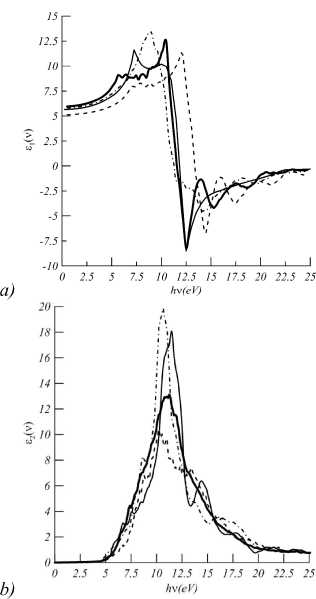
Fig. 3. Real (a) and imaginary (b) dielectric functions in predicted for carbon allotropes in PBE: solid line – cubic diamond, bold solid line – C28, dashed line –mtn, dash-dotted line – SiC12
Table 6. Lattice parameters for carbon allotropes calculated with POB-TZVP basis set and PBE exchange-correlation functional
|
Structure |
N |
a, Å |
b, Å |
c, Å |
Atomic positions |
|
diamond |
227 |
3.569 |
- |
- |
(0.125, 0.125, 0.125) |
|
lonsdaleite |
194 |
2.507 |
- |
4.169 |
(0.333, 0.667, 0.062) |
|
mtn |
227 |
9.625 |
- |
- |
(0.880, 0.067, 0.683), (0.125, 0.125, 0.625) (0.033, 0.033, 0.716) |
|
SiC12 |
166 |
2.511 |
- |
24.822 |
(0.667, 0.333, 0.740), (0.667, 0.333, 0.572) (0.667, 0.333, 0.511), (0.000, 0.000, 0.656) |
|
C28 |
55 |
7.298 |
7.728 |
2.535 |
(0.398, 0.039, 0.0), (0.376, 0.151, 0.5) (0.207, 0.270, 0.5), (0.239, 0.384, 0.0) (0.015, 0.196, 0.5), (0.460, 0.408, 0.0) |
|
4H-diamond |
195 |
2.534 |
- |
8.355 |
(0.000, 0.000, 0.093), (0.667, 0.333, 0.155) |
Table 7. Lattice parameters for carbon allotropes calculated with Pople’s 6-21 basis set and B3LYP exchange-correlation functional
|
Structure |
N |
a, Å |
b, Å |
c, Å |
Atomic positions |
|
diamond |
227 |
3.594 |
- |
- |
(0.125, 0.125, 0.125) |
|
lonsdaleite |
194 |
2.527 |
- |
4.205 |
(0.333, 0.667, 0.063) |
|
mtn |
227 |
9.688 |
- |
- |
(0.880, 0.068, 0.683), (0.125, 0.125, 0.625) (0.033, 0.033, 0.716) |
|
SiC12 |
166 |
2.534 |
- |
25.067 |
(0.333, 0.667, 0.073), (0.333, 0.667, 0.916) (0.333, 0.667, 0.844), (0.667, 0.333, 0.999) |
|
C28 |
55 |
7.301 |
7.735 |
2.538 |
(0.398, 0.039, 0.0), (0.375, 0.151, 0.5) (0.268, 0.270, 0.5), (0.239, 0.384, 0.0) (0.015, 0.197, 0.5), (0.460, 0.408, 0.0) |
|
4H-diamond |
195 |
2.513 |
- |
8.266 |
(0.000, 0.000, 0.093), (0.667, 0.333, 0.156) |
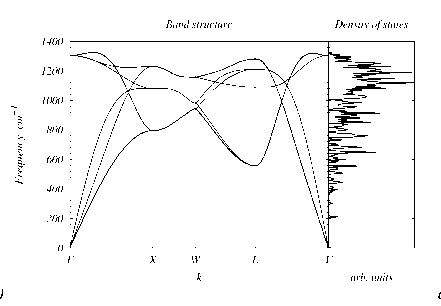
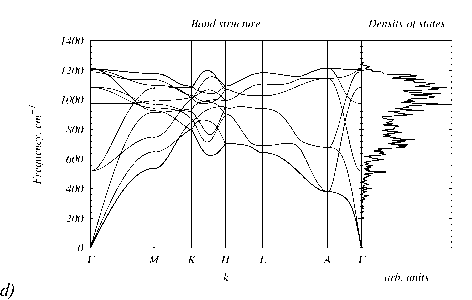

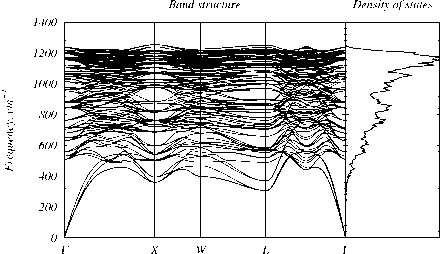
arb. units
Fig. 4. Phonon band structures and density of states of allotropes: a) diamond, b) SiC12, c) mtn, d) lonsdaleite, e) C28, f) 4H-diamond
Band structure
Density of states
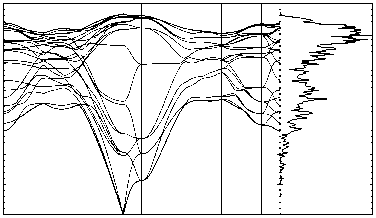
К
H
L M arb. units
M
c)
f)
Список литературы Optical properties of lowest-energy carbon allotropes from first-principles calculations
- Adachi, S. Optical constants of crystalline and amorphous semiconductors/S. Adachi. -New York: Springer Science & Business Media, 1999. -714 p. -ISBN: 978-0-7923-8567-7.
- Yang, N. Novel aspects of diamond: From growth to applications/ed. by N. Yang, -Cham, Heidelberg, New York, Dordrecht, London: Springer International Publishing Switzerland, 2015. -325 p. -ISBN: 978-3-319-09833-3.
- Zaitsev, A.M. Optical properties of diamond/A.M. Zaitsev. -Berlin, Heidelberg: Springer-Verlag, 2001. -502 p. -ISBN: 978-3-540-66582-3.
- Bundy, F.P. Hexagonal diamond -A new form of carbon/F.P. Bundy, J.S. Kasper//The Journal of Chemical Physics. -1967. -Vol. 46, Issue 9. -P. 3437-3446. - DOI: 10.1063/1.1841236
- Frondel, C. Lonsdaleite, a hexagonal polymorph of diamond/C. Frondel, U.B. Marvin//Nature. -1967. -Vol. 214. -P. 587-589. - DOI: 10.1038/214587a0
- Hirai, H. Modified phases of diamond formed under shock compression and rapid quenching/H. Hirai, K. Kenichi//Science. -1991. -Vol. 253, Issue 5021. -P. 772-774. - DOI: 10.1126/science.253.5021.772
- Hongliang, H. Direct transformation of cubic diamond to hexagonal diamond/H. Hongliang, T. Sekine, T. Kobayashi//Applied Physics Letters. -2002. -Vol. 81. -P. 610. - DOI: 10.1063/1.1495078
- Mao, W.L. Bonding changes in compressed superhard graphite/W.L. Mao, H.K. Mao, P.J. Eng, T.P. Trainor, M. Newville, C.C. Kao, D.L. Heinz, J. Shu, Y. Meng, R.J. Hemley//Science. -2003. -Vol. 302, Issue 5644. -P. 425-427. - DOI: 10.1126/science.1089713
- Hoffmann, R. Homo Citans and carbon allotropes: For an ethics of citation/R. Hoffmann, A.A. Kabanov, A.A. Golov, D.M. Proserpio//Angewandte Chemie International Edition. -2016. -Vol. 55, Issue 37. -P. 10962-10976. - DOI: 10.1002/anie.201600655
- Hu, M. Superhard and high-strength yne-diamond semimetals/M. Hu, Q. Huang, Z. Zhao, B. Xu, D. Yu, J. He//Diamond and Related Materials. -2014. -Vol. 46. -P. 15-20. - DOI: 10.1016/j.diamond.2014.04.005
- Wang, J.T. Mechanism for direct conversion of graphite to diamond/J.T. Wang, C. Chen, Y. Kawazoe//Physics Review B. -2011. -Vol. 84, Issue 1. -012102. - DOI: 10.1103/PhysRevB.84.012102
- Baburin, I.A. From zeolite nets to sp3 carbon allotropes: A topology-based multiscale theoretical study/I.A. Baburin, D.M. Proserpio, V.A. Saleev, A.V. Shipilova//Physical Chemistry Chemical Physics. -2015. -Vol. 17, Issue 2. -P. 1332-1338. - DOI: 10.1039/C4CP04569F
- Nesper, R. Hypothetical carbon modifications derived from zeolite frameworks/R. Nesper, K. Vogel, P.E. Blöchl//Angewandte Chemie International Edition. -1993. -Vol. 32, Issue 5. -P. 701-703. - DOI: 10.1002/anie.199307011
- Hohenberg, P. Inhomogeneous electron gas/P. Hohenberg, W. Kohn//Physics Review. -1964. -Vol. 136. -P. B864-B871. - DOI: 10.1103/PhysRev.136.B864
- Kohn, W. Self-consistent equations including exchange and correlation effects/W. Kohn, L.J. Sham//Physics Review. -1965. -Vol. 140. -P. A1133-A1138. - DOI: 10.1103/PhysRev.140.A1133
- Dovesi, R. CRYSTAL14: A program for the ab initio investigation of crystalline solids/R. Dovesi, //International Journal of Quantum Chemistry. -2014. -Vol. 114, Issue 19. -P. 1287-1317. - DOI: 10.1002/qua.24658
- Kresse, G. Efficient iterative schemes for ab initio total-energy calculations using a plane-wave basis set/G. Kresse, J. Furthmüller//Physics Review B. -1996. -Vol. 54, Issue 16. -P. 11169-11186. - DOI: 10.1103/PhysRevB.54.11169
- Pascale, F. The calculation of the vibration frequencies of crystalline compounds and its implementation in the CRYSTAL code/F. Pascale, C.M. Zicovich-Wilson, F. Lopez, B. Civalleri, R. Orlando, R. Dovesi//Journal of Computational Chemistry. -2004. -Vol. 25, Issue 6. -P. 888-897. - DOI: 10.1002/jcc.20019
- Maschio, L. Ab initio analytical Raman intensities for periodic systems through a coupled perturbed Hartree-Fock/Kohn-Sham method in an atomic orbital basis. I. Theory/L. Maschio, B. Kirtman, M. Rérat, R. Orlando, R. Dovesi//The Journal of Chemical Physics. -2013. -Vol. 139, Issue 16. -164101. - DOI: 10.1063/1.4824442
- Ferrero, M. The calculation of static polarizabilities in 1-3D periodic compounds. The implementation in the CRYSTAL code/M. Ferrero, M. Rérat, R. Orlando, R. Dovesi//Journal of Computational Chemistry. -2008. -Vol. 29, Issue 9. -P. 1450-1459. - DOI: 10.1002/jcc.20905
- Perdew, J.P. Generalized gradient approximation made simple/J.P. Perdew, K. Burke, M. Ernzerhof//Physics Review Letters. -1996. -Vol. 77, Issue 18. -P. 3865-3868. - DOI: 10.1103/PhysRevLett.77.3865
- Peintinger, M.F. Consistent gaussian basis sets of triple-zeta valence with polarization quality for solid-state calculations/M.F. Peintinger, D.V. Oliveira, T. Bredow//Journal of Computational Chemistry. -2013. -Vol. 34, Issue 6. -P. 451-459. - DOI: 10.1002/jcc.23153
- Becke, A.D. Density-functional thermochemistry. III. The role of exact exchange/A.D. Becke//The Journal of Chemical Physics. -1993. -Vol. 98, Issue 7. -P. 5648-5652. - DOI: 10.1063/1.464913
- Gordon, M.S. Self-consistent molecular orbital methods. 22. Small split-valence basis sets for second-row elements/M.S. Gordon, J.S. Binkley, J.A. Pople, W.J. Pietro, W.J. Hehre//Journal of the American Chemical Society. -1982. -Vol. 104, Issue 10. -P. 2797-2803. - DOI: 10.1021/ja00374a017
- Baima, J. Raman spectroscopic features of the neutral vacancy in diamond from ab ignition quantum-mechanical calculations/J. Baima, A. Zelferino, P. Olivero, A. Erba, R. Dovesi//Physical Chemistry Chemical Physics. -2016. -Vol. 18, Issue 3. -P. 1961-1968. - DOI: 10.1039/C5CP06672G
- Heyd, J. Erratum: Hybrid functionals on a screened Coulomb potential/J. Heyd, G.E. Scuseria, M. Ernzerhof//The Journal of Chemical Physics. -2006. -Vol. 124, Issue 21. -219906. - DOI: 10.1063/1.2204597
- Isaenko, S. Thermostimulated Raman spectrum dynamics of lonsdaleite/S. Isaenko, T. Shumilova//EGU General Assembly. -2012. -Vol. 14. -P. 608.
- Goryainov, S.V. Raman identification of lonsdaleite in Popigai impactites/S.V. Goryainov, A.Y. Likhacheva, S.V. Rashchenko, A.S. Shubin, V.P. Afanas'ev, N.P. Pokhilenko//Journal of Raman Spectroscopy. -2014. -Vol. 45, Issue 4. -P. 305-313. - DOI: 10.1002/jrs.4457

